火灾频率对稀树草原蝴蝶多样性和组成影响的初步研究
IF 1.1
4区 环境科学与生态学
Q3 BIODIVERSITY CONSERVATION
引用次数: 2
摘要
在许多生物群落中,火灾是一种频繁而广泛的干扰(Pausas & Keeley 2009),并通过改变植被结构和组成来塑造景观(Bond & Keeley 2005)。最近大规模不受控制的火灾事件增加(例如在西地中海盆地;Pausas & Fernández-Muñoz 2012;在北美北部地区;Kasischke & Turetsky 2006)和预测表明,由于气候变化,高强度火灾的频率将在未来增加(Pechony & Shindell 2010),这引发了人们对长期火灾制度变化影响的日益关注。随着人口密度和资产保护燃料管理压力的增加,火灾管理变得越来越重要(Gill & Stephens 2009)。与此同时,火也成为生物多样性保护的主要工具之一(Andersen et al. 1998;Parr & Chown 2003)。然而,目前仍有许多知识缺口阻碍了火灾管理中的明智决策(Driscoll等人,2010)。本文章由计算机程序翻译,如有差异,请以英文原文为准。
Effects of fire frequency on savanna butterfly diversity and composition: A preliminary study
Fire is a frequent and widespread disturbance in many biomes (Pausas & Keeley 2009) and shapes landscapes by modifying vegetation structure and composition (Bond & Keeley 2005). The recent increase in large uncontrolled fire incidences (e.g. in the Western-Mediterranean basin; Pausas & Fernández-Muñoz 2012; and in the North American boreal region; Kasischke & Turetsky 2006) and predictions indicating that the frequency of high-intensity fires will increase in the future as a result of climate change (Pechony & Shindell 2010) have triggered growing concerns about the impacts of changes in long-term fire regimes. Fire management has become increasingly important as both human population densities and pressure to manage fuels for asset protection increase (Gill & Stephens 2009). In parallel, fire has also become one of the primary tools for biodiversity conservation (Andersen et al. 1998; Parr & Chown 2003). Yet, numerous knowledge gaps are still currently impeding informed decision-making in fire management (Driscoll et al. 2010).
求助全文
通过发布文献求助,成功后即可免费获取论文全文。
去求助
来源期刊

Koedoe
BIODIVERSITY CONSERVATION-
CiteScore
3.30
自引率
0.00%
发文量
10
审稿时长
20 weeks
期刊介绍:
Koedoe, with the subtitle ''African Protected Area Conservation and Science'', promotes and contributes to the scientific (biological) and environmental (ecological and biodiversity) conservation practices of Africa by defining the key disciplines that will ensure the existence of a wide variety of plant and animal species in their natural environments (biological diversity) in Africa.
 求助内容:
求助内容: 应助结果提醒方式:
应助结果提醒方式:


